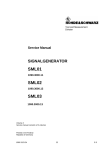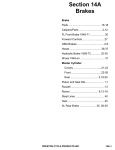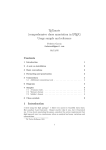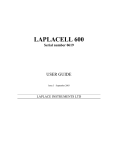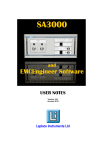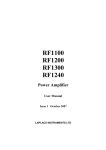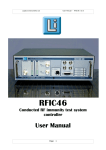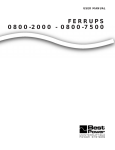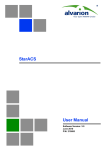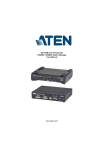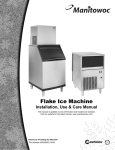Download User manual - Laplace Instruments Ltd
Transcript
RF1000 RF2000 RF3000 RF SIGNAL SYNTHESISER and SYSTEM CONTROLLER USER GUIDE ISSUE 4 November 2008 LAPLACE INSTRUMENTS LTD Laplace Instruments Ltd Page 2 Synthesiser Manual Laplace Instruments Ltd INDEX 1. Specification 2. Special note 3. Introduction 4. Hardware description 4.1. 5. Hardware interconnections Software operation 5.1. Installation 5.2. Overview 5.3. Operating procedures 6. Software Reference 7. File formats Page 3 Synthesiser Manual Laplace Instruments Ltd Page 4 Synthesiser Manual Laplace Instruments Ltd 1.0 Synthesiser Manual SPECIFICATION Output carrier frequency: RF1000 30MHz – 1.0GHz RF2000 30MHz - 2.4GHz RF3000 30MHz – 3GHz Control: From supplied PC software via USB port. Environment: Windows NT, XP, Vista Resolution: 0.5% of current value Main control: Step size: 0.2% to 5% of current value Start test (RUN) Stop test (STOP) Pause at frequency (Dwell) Single frequency mode Level (carrier signal): Indication: -60dBm to 0dBm Bargraph indication of level. Setup screen: THD (worst case): 10% Modulation: off, 1KHz sine, 80% AM modulation 200Hz, 20Hz & 1Hz pulsed. 100% level Enables all parameters of a test scan and EUT details to be programmed. Start and end frequencies Frequency step (% of current value) Field strength (0 - 10V/m) Dwell time (1 - 99 seconds) Modulation mode. Parameters: Single freq. Screen: Manually or automatically ramp the field strength at one frequency. Output connector: BNC Ext. feedback probe: Input: 0-2.5V Calibration via PC software. 5V @ 20mA dc. 8 pin circular Custom scan: Specify field level vs frequency Report screen: including vs. target Plot all details of the test setup parameters, actual settings and EUT status. Open loop (preprogrammed) or closed loop. Status window: Real time indication of operating mode, EUT status and P.A. EUT status: Fault modes: Connector: 5V relay input Stop, pause, continue. 3 pin circular Menus File: EUT prompt: 4 pole c/o volt free contacts. Pulsed, Continuous, off 15 pin Dee type can Mode: Select operating mode and test sequence. Standard IEC tests pre-programmed. Contact closure enforces standby mode. 4 pin circular Config: Enter cell characteristics, Probe calibration, P.A. characteristics Indication: Mains power Output signal level (bargraph) P.A. status, EUT status, EUT prompt Excitation: Connector: Mode: Modes: Connector: P.A. interlock: Connector: General Supply: Size: Weight: status. All standard Windows facilities, including printer output and file Save, Open commands. Test results and setup data be stored/recalled separately. 110V or 230V, auto sensing. 50 or 60Hz 120 x 64 x 188mm 3.5kg Page 5 Laplace Instruments Ltd 2. Synthesiser Manual SPECIAL NOTE The RF1000/2000/3000 are designed for use with the LaplaCell range of EMC test cells. These cells are fitted with a field sensor to provide feedback to the field strength level control system. These synthesisers will not work correctly unless this feedback signal is present. If the unit is to be used without the cell connected, option –RH is available which includes a remote sensor interface which is connected via the RS232 port on the rear panel. This will accept feedback from Holaday or EMC Test Design standard probes. In this mode 2.1 Remote sensor option for anechoic chamber operation The RFx000 can be used with a Holaday or EMC Test Design field sensor (or equivalent) for use in anechoic chambers. This -RH option must be specified at time of ordering. This manual will apply in all respects apart from the following: Sensor requirements: The system is designed for the Holaday HI-4422 or the HI-6005 sensors or the EMC Test Design ‘Smart Probe’ RFP-04CE probe (or equivalents). The sensor should be connected to the synthesiser via the appropriate fibre optic cable and serial adaptor. This adaptor is connected via the serial port provided on the rear panel of the unit. The synthesiser will recognise the probe and power the adaptor automatically. If the sensor is not connected, or if the sensor battery is flat, the system will not run when RUN or PRE-SCAN is inititated. In operation, the software will work as described in the following sections. Both closed loop (sensor used alongside the EUT) and open loop (Pre-scanned with EUT absent) modes can be used. In addition, the sensor can be used to check and calibrate the test volume using the pre-scan mode and by processing the resultant pre-scan data in (for example) Excel. Page 6 Laplace Instruments Ltd Synthesiser Manual 3. INTRODUCTION The RF1000/2000 RF signal synthesiser is specifically designed to provide the signals required for testing RFI immunity of products to international standard IEC61000-4-3. IEC61000-4-3 IEC61000-4-3 immunity testing requires that the EUT (equipment under test) operates satisfactorily when subject to a strong electromagnetic field. This requires a scan at a certain fixed level (specified by the standard) of field strength. The scan will comprise a series of ‘steps’ in frequency. Each step is specified as a percentage of current frequency value. This percentage is variable from 0.2% to 5%. At each step, the frequency is held, the level adjusted to achieve the required field strength as measured by a field sensor, a prescribed modulation mode is initiated and then the conditions held for a ‘dwell’ time. The EUT should be monitored to detect faulty operation during the test. During the dwell time, a 1KHz, AM modulation at 80% depth is applied to the signal. In addition, a specific test is required at 900MHz with a pulsed modulation of 100% depth to simulate the fields which may be experienced from mobile phones. The synthesiser generates a signal at the required frequency, modulation and level which can be fed to transmitting antenna or test chamber via a fixed gain Power Amplifier. If used with a compact cell the Laplace RF1100, RF1200 and/or RF1300 amplifiers make ideally matched companions. Typical System Frequency and modulation are simple set values but the level is controlled via a field strength sensor feedback loop. (But see note in first section) The PC will provide the level set point in terms of sensor output (i.e. already adjusted to take account of cell characteristics) Two modes are available: real time feedback or pre-programmed level. The former takes account of the effect of the EUT inside the cell. The Synthesiser also acts as an interface to the EUT with status input and ‘prompt’ outputs to exercise the product at each step. A single frequency mode is available in which the cell is effectively controlled directly by the operator from the PC, enabling specific weaknesses in the EUT to be investigated. Page 7 Laplace Instruments Ltd Synthesiser Manual Immunity system components • Synthesiser The RFx000. Linked to PC via USB port. Generates the required signals and controls the amplitude to produce required field strength inside cell. Also interfaces simple EUT status signal back to PC and generates simple ‘prompt’ signal to EUT under PC control • PC with RFSynth software package. User interface and main control for the system. • EUT monitoring facilities • EUT excitation and monitoring. The software will enable the use of standard PC plugin cards (e.g. Keithley or National Instruments or others) and standard control/acquisition package such as DasyTec or Labview with DDE interchange to monitor the EUT status and/or to trigger test cycles. • Video interface running in separate window. Camera and camera hardware interface and software are supplied separately. Cell characteristics The cell may be distinctly non linear in frequency characteristics. Generally each cell is individually calibrated by the manufacturer and the resultant characteristics programmed into the software. Field control technique There are two quite distinct ways in which field strength can be controlled. The synthesiser allows use of both techniques. To understand the background to these alternative techniques, imagine the following scenario: The equipment to be tested (EUT) is to be used in an area close to a strong transmitter, perhaps a TV station, and may therefore be subject to quite strong RF fields. Indeed in one location at which the product is to be located, the field strength from the transmitter is 10V/m, as measured with an accurate field strength probe prior to installing the product. When the product is installed at this location, it will modify the field in this vicinity, possibly reducing the field to only 5V/m simply due to the RF characteristics of the product. The question is therefore raised: how should the product be tested? Either: 1. Open loop mode (Pre-scan). Generate the 10V/m in the ‘empty’ space first, then place the product into that space but do not attempt to control the field strength which may now have suffered a significant change. This emulates the ‘real world’ situation as described above, but may result in actual field strengths applied to the product significantly less than the 10V/m nominal. Or: 2. Closed loop mode (Standard). Control the field strength with the product in the ‘space’ to give 10V/m. This may appear to to more ‘correct’ but could give a false impression of the performance of the produce in actual situations. The synthesiser and the software permit both techniques. Technique 2 is generally used, but the use of technique 1 can often lead to useful information about the characteristics of the product, for instance it can show at which frequencies (if any) the product becomes a significant absorber of RF power. In this system, technique 2 is the default (standard) technique. Page 8 Laplace Instruments Ltd Synthesiser Manual 4. Synthesiser Hardware Description The RF1000/2000/3000 acts as the ‘hub’ of the immunity test system. It generates the signal that is applied to the EUT, controls the field strength via a feedback signal from the cell, provides interfaces for the EUT and interfaces to the controlling PC via the serial port. The features of the front panel are: 1. 50ohm BNC for signal out. This signal should be taken via a suitable RF power amplifier to the cell or antenna. Maximum signal out is typically +3dBm at 30MHz and -6dBm at 3GHz. 2. Signal out level indication. This is provided so that the user can visually observe the activity of the system. Note that this level does not represent field strength, that is largely determined by the characteristics of the amplifier/cell or antenna. When using the LaplaCell, this indication is generally around half scale for most field strength settings, but will approach full scale at certain frequencies for the highest field strengths. NOTE: An excursion into the red zone does NOT indicate an overload, it simply indicates that the output is approaching full scale. 3. EUT prompt output. This enables the system to ‘prompt’ the EUT each time the test begins a ‘dwell’ period. This can ensure that the EUT is fully exercised at all test frequencies during the test. See section 4.1.1 4. EUT status input. This requires a contact closure to indicate that the EUT is OK, Open circuit indicates an EUT failure. The status is transmitted to the PC for indication on the RFSynth software screen and for action if so required. See section 4.1.1 5. PA status. Monitors the power amplifier normal/standby status. See section 4.1.4 6. Feedback probe input. When used with the LaplaCell, this is connected directly to the corresponding 5 or 8 pin socket on the cell. This connection supplies power to the cell (certain models only) and returns the analogue field strength measurement and the cell door interlock signal. 7. Mains power ON/OFF indicator. 8. Standby. When illuminated, indicates that the system is running with the output signal fully attenuated and is effectively in ‘standby’ mode. 9. P.A. status. Indicates that the Power amplifier has been switched into ‘standby’ mode, either by direct switch action on the PA, or due to the opening of the cell door. 10. EUT Status. Indicates the condition of the EUT status signal. When illuminated, indicates that the EUT is OK. 11.EUT prompt indication shows when the prompt signal is on. Page 9 Laplace Instruments Ltd Synthesiser Manual Rear panel • Mains input. CAUTION. Early models were set for eityer 110V or 240V input power. Check the mains voltage corresponds to the voltage label next to the mains input socket. Applying 230V to a 110V unit will cause damage. Later models are dual voltage, 110 – 240V ac. If the panel is marked for this range, either 110V or 240V can be used. • If the mains voltage setting for the early models of the Synthesiser needs to be changed from 230V to 110V or vice versa, the unit must be returned to the factory. • Mains switch. This reveals a red indication when the switch is on. Press ‘1’ for on and ‘0’ for off. • USB port. Connected to the USB port on any standard PC. Use the cable supplied with the Synthesiser. • Serial (RS232) port. ONLY used if the ‘remote sensor’ (-RH) option has been specified. ================================================================= CAUTION • Ensure equipment is properly grounded to earth before use. • Do not cover any ventilation slots. • Ensure correct mains voltage. • Use only ‘volt free’ contacts for the EUT status signal. ================================================================= Page 10 Laplace Instruments Ltd Synthesiser Manual 4.1 Interconnections 4.1.1 EUT status connections These connections relate to the monitoring of the EUT whilst immunity testing is ongoing. Immunity tests can take some time, so automatic monitoring is an advantage as it avoids the need for continuous presence of a person during the test. EUT status Indication of EUT status must be returned to the Synthesiser as a volt-free contact circuit, open representing EUT good. Because every EUT is different, the EUT interface circuit must be designed to suit each individual application. If there are many parameters to be monitored, they must be logically OR’ed together to provide a contact closure if any parameter is not OK. Either pin 1 or 3 may be used for the return connection. EUT Prompt The prompt output from the Synthesiser is a 4 pole c/o relay. All the contacts are brought out to a standard 15 way Dee type connector. Connection details Common 10 11 12 13 Notes: • NO contacts are closed when EUT prompt operates • NC contacts are opened when EUT prompt operates • Contact rating is 20v rms or 40v dc, 300mA. • When pulsed prompt is used, contacts close for approx 1 second. Page 11 NO 1 3 7 15 NC 9 2 8 14 Laplace Instruments Ltd Synthesiser Manual 4.1.2 System Connections This diagram shows the cabling connections when using the Synthesiser with a single power amplifier. All 4 cables shown in this diagram are included with the shipment. The optional connections to the EUT prompt and EUT status sections are supplied with the appropriate mating halves. Note that if the system is used with remote sensor, the control connection to cell is redundant and not supplied. If using the Synthesiser with both the RF1100 and RF1200 or RF1300 power amplifiers, the three cables which connect to the power amplifier must be switched over at 1GHz. a) b) c) d) e) f) Connect supplied USB lead from USB port on PC to rear panel connector on Synthesiser. Connect RF output lead from Synthesiser to RF input on RF1100 power amplifier (P.A.), with the supplied BNC - BNC lead. Connect RF output from RF1100 to cell RF connector (N type) using cable provided. Note, normally ALWAYS leave this cable connected to cell. When disconnecting the RF1100 or any other device (eg EMC analyser), always disconnect at the end remote from the cell. (If not using a cell, connect to a suitable antenna or other load) Connect the supplied 8 way cable from the cell to the SYNTHESISER. Not required if not using a cell, but note that either an alternative field sensor must be connected or the internal feedback link set internally. Connect the supplied 4 way cable from the Synthesiser to the RF1100. Note that when using the LaplaCell, the 3 way connector on the RF1100 is not used. Page 12 Laplace Instruments Ltd Synthesiser Manual 4.1.3 LETIS The LETIS (Laplace EMC Test Integration System) enables all the switching between power amplifiers to be done automatically. If using this unit, the interconnections are as shown below. Note that this diagram is for a complete system which includes the SA1002 or SA3000 analyser for emissions measurement. SA1002/ SA3000 RFSynth RF1100 LETIS RF1200/RF1300 4.1.4 System interconnection circuits These are provided so that the Synthesiser can be interfaced with other third party hardware. When using Laplace ancillaries, this section is redundant. PA Status Page 13 Laplace Instruments Ltd Synthesiser Manual Probe Not used when the ‘remote sensor’ option is specified. The sensor is connected at the rear panel. The RFx000 requires an analogue signal for field strength feedback. The nominal sensitivity should be 2v feedback signal for 10V/m field strength. The standard version of the RFx000 assumes a response time of approx 10ms to match the performance of the probe included with the LaplaCell. If an alternative probe is to be used, ensure the response time is similar or shorter than the 10ms quoted above. If a probe with a longer response time is to be used, contact Laplace Instruments Ltd or the distributor for advice. This connector provides +5v at 20mA for probe power and a connection for the cell door interlock. The 8 way cable supplied with the LaplaCell provides all the required interconnections. Page 14 Laplace Instruments Ltd Synthesiser Manual 5. Synthesiser Software The software programme (Rfsynth3) supplied with the Synthesiser is a Windows application which will run under Windows NT, XP, 2000 and Vista. This program has the following functions: • • • • Control of the Synthesiser Programming of the test sequence Display of the results of the test Recording of results and setups to disk, and subsequent opening of those saved files. 5.1 Installation To install the program, insert the floppy disk or CD and run ‘install.exe’. This should create a directory called c:\Program Files\Laplace Instruments Ltd\Rfsynth and copy files into this directory. 5.1.1 Installation of the Synthesiser USB Device Drivers under Windows. Connect the Synthesiser to the USB port on your computer using the supplied cable and switch on the Synthesiser. Windows should automatically detect that the USB device has been connected and prompt for a device driver. Select the Install from a list or specific location (Advanced) and click Next. Page 15 Laplace Instruments Ltd Synthesiser Manual Type c:\Program Files\Laplace Instruments Ltd\RfSynth or select the directory using the Browse button. Wait while windows copies the files into its system folders. Page 16 Laplace Instruments Ltd Synthesiser Manual Click Continue Anyway Wait while windows copies the files into its system folders. Click Finish. Page 17 Laplace Instruments Ltd Synthesiser Manual Repeat the sequence for any other USB devices connected (eg LETIS). Windows will automatically prompt you to load the second USB device driver. You should now copy any calibration file (cell0nnn.csv) from the floppy/CD into the same directory. (c:\Program Files\Laplace Instruments Ltd\Rfsynth3). For remote sensor operation, the calibration fiel is cell0HOL.csv To start the program, run RfSynth3.exe and/or create an icon and shortcut on the desktop. Page 18 Laplace Instruments Ltd Synthesiser Manual 5.2 Overview The screen layout The screen is divided into 8 main areas: 1. The Main Menu bar across the top in a conventional Windows application style. A full description of each menu item is given later. 2. The status indicator areas running down the left hand side. Synthesiser operating condition EUT status System fault indicators. i) ii) iii) 3. The Main operating control buttons Controls RUN, STOP and Pause (Dwell) 4. The Main operating mode selection 5. The Monitor area. Displays current test parameters, continuously updated as a test proceeds. 6. The main setup and results display area. This area shows one of 4 different screens, one for each of three operating modes plus a reporting page, selected by the Operating Mode Select buttons at the lower edge of the screen. 7. i) The three operating modes are: Standard Scan - For conventional frequency scan of signal at fixed level (V/m). Page 19 Laplace Instruments Ltd ii) iii) iv) Synthesiser Manual Single Point (frequency) - Manual or semi-automatic control of frequency and level for single frequency testing and investigative work. Custom Scan - Enables programming of complex scan profiles as required, for example, by products which are sensitive to certain frequencies (eg radio receivers). Report Results - Displays a screen on which the results of a test are plotted graphically for ease of viewing and interpretation. Main Operating Modes The system has 3 quite separate modes of operation. Each mode can be automated so that testing can be undertaken unattended. The modes are: 1. Standard mode. Conventional scans between a start and finish frequency at a fixed field strength level and programmable step size. Modulation, EUT prompting and EUT monitoring as required. 2. Single frequency mode. Manual control of frequency and field strength so that specific problems can be investigated. In addition this mode provides secondary features: 3. a) Can be used for the 900MHz, pulsed field test required by the standards for testing mobile phone immunity. b) Provides an automated feature for gradually increasing the field strength until an EUT fault is detected, thus providing a means of checking the actual failure level of a product. Custom scan mode. Enables a frequency vs. field strength profile to be programmed. In addition, the Standard and Custom scan modes can be run with either the normal (using probe feedback for field control) technique, or with the ‘Pre-Scanned’ technique. See section 5.1.5 ==================================================================== In the next sections the operation of the software is described in terms of the procedures which would typically be adopted for a practical application. ==================================================================== Page 20 Laplace Instruments Ltd Synthesiser Manual 5.3 Operating Procedures 5.3.1 Initial test (Standard Mode) 1. 2. 3. 4. 5. Install, configure and connect the EUT inside the test cell. (For the purposes of this description, use of the LaplaCell will be assumed. Connect the EUT status and EUT prompt interface to the Synthesiser, if available (see section 4.1.1) Connect system cables as shown in section 4.1.2.. Switch the Synthesiser and RF1100 and/or the RF1200/RF1300 ON. Check the Configure… System menu and ensure that the correct cell model is selected and the the correct current cell serial number is entered. . If the remote sensor option is used, select HOL as the current cell number. 6. 7. 8. 9. 10. Check Comms and Synth. Fault status indicators are not showing. If using the cell camera and/or internal lighting, position these for optimum viewing and connect via DIN socket in EUT connection panel on the cell. Ensure P.A. standby button is out (not illuminated). Close cell door if necessary. Check all EUT related systems are working properly. a) EUT operation. b) EUT status interface (check response on Synthesiser software screen when EUT ‘fails’). c) EUT prompt signal. (Use menu item Mode...check EUT prompt....) d) Cell door interlock. (Opening the door should cause P.A. fault indicator to show and P.A to go into Standby mode) When all is ready to start the test, the test parameters can be entered in the Standard mode window. Page 21 Laplace Instruments Ltd a) b) c) d) e) f) g) h) 11. Synthesiser Manual Type in the start and finish frequencies. Note that the maximum frequency is determined by the synthesiser model. Type in the required field strength. Enter the required step size in %. For normal testing 0.5% or 1% is used. However for a fast scan, a larger step size can be used. For very careful testing for narrow band effects, smaller step sizes can be used. Select EUT prompt OFF or Pulsed or ON as required. Select EUT status either OFF (if not used) or Halt if the test is to be stopped in the event of an EUT failure, or Continue if an EUT failure is to be ignored. Select dwell time at each test frequency in seconds. Click on the Estimated Time field to update the calculated total time for the test. Select the required modulation. For most tests involving a scan the 1KHz modulation is normally used. Alternatively, an IEC61000-4-3 standard scan can be selected under the main menu item Mode...IEC Tests... This will load a pre-programmed scan with the correct settings. Note that Dwell time and Step (%) are left to the user. Page 22 Laplace Instruments Ltd Synthesiser Manual 12. Once the scan is fully programmed, click on he REPORT RESULTS button to view the results of the test as the test proceeds. The target field strength profile will be displayed as a blue line. 13. Click on the RUN button (lower left hand edge) and the test will begin. NOTE: If using the Lc600 or Lc300/2 cell, ensure that the frequency range switch on the cell is set to Auto position. The Synthesiser will automatically switch the cell range as required. If the switch is set to a manual position, the software will flag an error. a) The system Status indicators will initially show ‘Settling’ as the system creates the required frequency and then ramps up the field strength to the desired value. When the correct conditions are achieved, the Status indicators will change to ‘Running’ and, if modulation is selected the ‘Modulation’ indicator will show. b) The actual field strength achieved will be shown as a red line on the REPORT RESULTS screen. This should appear close to the target (blue) line. c) The EUT status (if relevant) will be indicated in the Status indication area and as a red/green line below the REPORT trace. d) Actual achieved frequency and field strength will be reported in the monitor window, together with current dwell time and total elapsed time. e) f) g) At any time during the scan the dwell time at any particular frequency can be extended indefinitely by clicking on the DWELL button on the lower edge of the screen. The DWELL button will also act as a RESUME button. To stop the scan, click on the STOP button. If the test is allowed to proceed until either the scan reaches the Finish frequency or the EUT causes the scan to stop (EUT Status set to Halt), an End of Run message will be shown and the system returned to standby mode. Page 23 Laplace Instruments Ltd Synthesiser Manual Range select buttons:30-1000MHz or 30-2000MHz or 1000 – 2000MHz Target field strength profile (blue) EUT status indicator 14. On studying the results, it may be decided to study the performance of the EUT at one particular frequency, perhaps one at which the product had indicated a failure. This can be accomplished by using the Single Frequency mode by clicking on the SINGLE button. 5.3.2 Investigative Test - Single frequency mode 1. Single frequency mode enables the user to set a frequency and modulation mode and to manually control the field strength using simple UP and DOWN buttons. Frequency can also be adjusted in the same way. 2. Enter the desired frequency in the Frequency field, or click on the UP or DOWN buttons until the frequency is reached. Note that the step size is set by the Step Inc. field. Page 24 Laplace Instruments Ltd 3. 4. 5. 6. 7. 8. 9. Synthesiser Manual Set the starting field strength Level in the Level field. Click on the RUN button. The system will ramp up to the set level and remain a that level. The frequency and level can be adjusted by clicking on the appropriate UP or DOWN buttons. If modulation is required, select the appropriate modulation in the pull-down menu. The modulation will only change when one of the frequency or level buttons is clicked. The MONITOR area will show the actual achieved levels and frequency. The RESULTS window will show the progress of the test. To end the test, click on the STOP button. 5.3.3 Investigative test - Auto increment mode This can automate the process of measuring the field strength level at which a product fails. 1. 2. 3. 4. 5. 6. Auto increment mode enables the EUT to be tested in a gradually increasing field strength at one frequency, until (if desired) an EUT fault occurs at which point the test will terminate. The REPORT screen will show the results of the test. To begin this mode, click on AutoIncrease on the Single Frequency mode screen. a) Set the required frequency in the Frequency window. b) Set the required start and stop V/m levels and the step size, also in V/m. c) Set the Dwell time at each level. d) If the test is to be stopped when an EUT fault is detected, enable the ‘Stop on EUT Fault’ mode. e) If modulation is required, ensure that the required modulation type is selected in the modulation field. When the parameters are all set, click on the RUN button. If the operator needs to dwell at any one level for an extended period, click on the DWELL button. STOP will terminate the test. If the test runs through to completion, the system will automatically return to standby mode and show a Run is Completed message. 5.3.4 Custom Scan Mode In some cases it may be necessary to vary the field strength as the scan proceeds. Situations where this would be an advantage is if the EUT is intentionally sensitive at certain frequencies and should be be subjected to strong fields at these points. A telemetry receiver would be an example Page 25 Laplace Instruments Ltd Synthesiser Manual of this. Alternatively, products which have to work in the vicinity of strong transmitters may be tested at a lower field for most frequencies (maybe 3V/m, domestic environment), but at transmitter frequencies, a higher field strength would be sensible. Custom scan mode enables a field strength vs frequency profile to be entered. A table is provided on the CUSTOM mode screen where frequency and field values can be entered. The software automatically performs straight line interpolation between consecutive points. If for instance a product which is normally intended for class B environments (domestic and commercial) but which may be used close to 456MHz telemetry transmitters, is to be tested, then the table could be entered as follows: Frequency MHz 80 452 454 458 460 1000 Level V/m 3 3 10 10 3 3 Once entered, the resulting profile can be checked by switching to the RESULTS screen. As with the STANDARD screen, the other parameters that can be set are: • Dwell time at each test frequency • Step increment in % • Modulation • EUT prompt • EUT status monitoring The estimated time window will calculate the total time for the test as each parameter is changed. Page 26 Laplace Instruments Ltd Synthesiser Manual 5.3.5 Pre-Scan mode As discussed in chapter 3 there are two quite distinct ways in which field strength can be controlled. The Synthesiser allows use of both techniques. To understand the background to these alternative techniques, imagine the following scenario: The equipment to be tested (EUT) is to be used in an area close to a strong transmitter, perhaps a TV station, and may therefore be subject to quite strong RF fields. Indeed in one location at which the product is to be located, the field strength from the transmitter is 10V/m, as measured with an accurate field strength probe prior to installing the product. When the product is installed at this location, it will modify the field in this vicinity, possibly reducing the field to only 5V/m simply due to the RF characteristics of the product. The question is therefore raised: how should the product be tested? Either: 1. Generate the 10V/m in the ‘empty’ space first, then place the product into that space but do not attempt to control the field strength which may now have suffered a significant change. This emulates the ‘real world’ situation as described above, but may result in actual field strengths applied to the product significantly less than the 10V/m nominal. Or: 2. Control the field strength with the product in the ‘space’ to give 10V/m. This may appear to to more ‘correct’ but could give a false impression of the performance of the produce in actual situations. The Synthesiser and the software permit both techniques. Technique 2 is generally used, but the use of technique 1 can often lead to useful information about the characteristics of the product, for instance it can show at which frequencies (if any) the product becomes a significant absorber of RF power. In this system, technique 2 is the default (normal) technique and this is what is applied in all the test techniques described so far.. Pre-scan mode enables technique 1 to be implemented. The SYNTHESISER system controls the field strength inside the cell by adjustment of the RF signal output to the amplifier. This signal is fed via a digitally controlled variable attenuator which is in turn controlled by the software. In short, the software can dictate the precise level of the RF output to the cell, independently (if required) of the feedback from the cell. Pre-scanning can be applied to both Standard and Custom modes. When the test is fully defined in the Standard setup or the Custom setup screen, ensure that the cell is empty and click on the PRE-SCAN button (not the normal RUN button). The system will now perform a complete sweep as dictated by the settings, but will not dwell at any of the steps. Instead, it keeps a record in memory of the attenuator settings needed to create the required field strength. When this PRE-SCAN is completed, the EUT can be placed in the cell. To then do a Pre-Scanned RUN, simply click on the RUN button. By default, once a PRE-SCAN sweep has been done, subsequent RUN operations will use the Pre-scanned data to set the level, rather than using the feedback to control the level. Page 27 Laplace Instruments Ltd Synthesiser Manual To exit this mode and to return to normal (conventional) control of the field strength, switch to the Standard setup screen and click the ‘Test Type’ ,….. ‘Normal’ selector. The REPORT RESULTS screen will show the target level, as normal, plus the actual field strength inside the cell as measured by the field probe. This feedback is not used for the control, but gives an indication of how the EUT is reacting to the applied field. For instance, if the EUT is such that it absorbs RF energy at a particular frequency, this will be shown in the feedback level. Page 28 Laplace Instruments Ltd Synthesiser Manual 6 Software Reference File menu File....Open.... File....open....results Loads all setup parameters and results of a previously saved test. Overwrites all the parameters and data currently in memory. File...open....Setup only Loads previously saved setup parameters only. File....open....pre-scan Loads pre-scan data, complete with all setup parameters. File...Save Stores current results and setup information using the file name last used. This will overwrite any previously stored information. File....Save as.... Conventional ‘Windows’ function. Allows file name, directory and drive to be defined by the user. File....Save as....Results & Setup All setup parameters and test results stored with file extension .rf File....Save as....Setup Only Setup parameters stored with file extension .stp File....Save as....Pre-Scans Pre-scan data (attenuator settings) stored with all setup parameters with file extension .psc Print options Conventional printer facilities for the creation of hard copy results. Page 29 Laplace Instruments Ltd Synthesiser Manual Print.....Plot Prints the plot as shown on the RESULTS screen, plus details of setup parameters, Title, Notes, Date and time and file name (if given) Print....Tabular Prints the results data as a tabular listing in 5 columns: Result No:, Frequency, Actual level, Target level, EUT status. Printer Setup Enables the printer configuration and parameters to be selected. Parameters include printer type, paper size, orientation, network options and printer mode. File....Title and Notes These allow the user to add a title (which appears near the top of the screen) and notes. The notes are written to a separate window but always appear on any printout and are automatically saved to file with the Store.... options. File....Exit Exits the program. Any data not Stored to disk will be lost Display Display....Colours The screen colours used on the results plot may be changed to suit individual preferences or to optimise display performance. Display....Clear Clears the Results plot and resets all result information to zero Display….Show Field Warning Messages These messages are shown if the field strength achieved is not within a tolerance band of the set level. Page 30 Laplace Instruments Ltd Synthesiser Manual Mode.... Mode....IEC Tests.... Selects the parameters required for testing to the standard IEC61000-4-3. Frequency start and finish, modulation and field level are loaded. Options allow the domestic & commercial levels or the Industrial levels. The user must specify Dwell time, frequency step, EUT prompt mode and EUT monitor mode. Mode....Standard mode Mode....Single Freq. Mode Mode....Custom Scan | These options select the | operating mode with the | same effect as the mode | buttons along the lower edge Configuration.... Configure....RF Series Standard Power Amplifier used with this system. Configure....FLH10 Alternative power amplifier. Configure….PA Other.... Entry of third party Power Amplifier identification. Configure....System Selects file delimiter used for results data. This can be changed to suit any spreadsheet or other program that may be required to import the data. Also sets cell serial number. This is required so that the software can ‘look up’ the appropriate cell calibration file. This file should be included with the test cell and will have a file name of cell0nnn.csv, where nnn is the cell serial number. This file should be installed in the same directory as the program. The USB device status is also shown. Page 31 Laplace Instruments Ltd Synthesiser Manual Page 32 Laplace Instruments Ltd 7 Synthesiser Manual File Formats EOF INI file format Record ordercolor gridcolor screencolor eutokcolor eutfailcolor achievecolor setpointcolor pgridcolor psetcolor pachievecolor peutokcolor peutfailcolor ptextcolor comstyle bbrate delimitor cellname pscancolor 'spare' 'spare' 'spare' 'spare' 'spare' currentfreq startlevel endlevel steplevel singledwelltime startfreq endfreq Standard mode stepsize dwelltime mode setpoint totaltime modulation promptindex statusindex singlelevel Description Colour of border Colour of grid Colour of screen Colour of EUT OK Bar Colour of EUT Fail Bar Colour of achieved level Colour of Target Print colour of grid Print colour of Target Print colour of level achieved Print colour of EUT OK Bar Print colour of EUT Fail Print colour of text Com Port used (0 for simultn) Baud rate used Delimitor used in files Cell identifier Colour of prescan trace Five spare lines Current frequency Start point of V/m End point of V/m Step for single frquency auto Dwell time for single freq. Start freq. for Standard mode End freq. for Freq. step for standard mode Dwell time for Standard Target V/m for Standrd mode Total estimated time for test Style of modulation selected Style of EUT prompt selected Style of response to EUT fail Target level for Single frequency mode PA style flag Mode style flag Four spare lines pastatus modeflag 'Spare3' 'Spare4' 'Spare5' 'Spare6' customdata customdata frequency level ........ ....... 30 sets of Custom Data points ........ ....... Page 33 Laplace Instruments Ltd Synthesiser Manual TEST RECORD data file format singlelevel Record Description Software Version softversion Date & Time label14.caption Title titlestring Procedure Name procstring currentfreq startlevel endlevel steplevel singledwelltime startfreq endfreq Standard mode stepsize Label Software Version Label Date and Time of test Label Title of test Label Procedure name Current frequency Start point of V/m End point of V/m Step for single frequency auto Dwell time for single freq. Start freq. for Standard mode End freq. for pastatus modeflag 'Spare3' 'Spare4' 'Spare5' 'Spare6' customdata customdata frequency level ........ ....... 30 sets of Custom Data points ........ ....... finish Label dwelltime mode setpoint totaltime modulation promptindex statusindex Freq. step size for standard mode Dwell time for Standard Target V/m for Standard mode Total estimated time for test Style of modulation selected Style of EUT prompt selected Style of response to EUT fail PRE SCAN DATA file format Record currentfreq startlevel endlevel steplevel singledwelltime startfreq endfreq Standard mode stepsize dwelltime mode setpoint totaltime modulation promptindex statusindex singlelevel pastatus modeflag ‘Spare3' Description Current frequency Start point of V/m End point of V/m Step for single freq. auto Dwell time for single freq. Start freq. for Standard mode End freq. for Freq. step size for standard mode Dwell time for Standard Target V/m for Standard mode Total estimated time for test Style of modulation selected Style of EUT prompt selected Style of response to EUT selected Target level for Single frequency mode PA style flag Mode style flag Four spare lines Page 34 Target level for Single frequency mode PA style flag Mode style flag Four spare lines 'FREQUENCY ',**,' LEVEL',**,' EUT' ...... ..... ....... variable number of result lines ...... ..... ....... frequency ** amplitude ** EUTindicator ...... ..... ....... (Number of lines of data depend on the number of results taken) EOF Note: ** represents delimiter as selected in ‘System’ menu 'Spare4' 'Spare5' 'Spare6' customdata frequency 30 sets of Custom Data points ....... .......... customdata level ....... ......... frequency ** prescan setting ....... ........ ....... 500 lines of pre scan data: ....... ........ ....... EOF Laplace Instruments Ltd Synthesiser Manual SET UP ONLY file format Record currentfreq startlevel endlevel steplevel singledwelltime startfreq endfreq Standard mode stepsize dwelltime mode setpoint totaltime modulation promptindex statusindex singlelevel Description Current frequency Start point of V/m End point of V/m Step for single freq. auto Dwell time for single freq. Start freq. for Standard mode End freq. for Freq. step size for standard mode Dwell time for Standard Target V/m for Standard mode Total estimated time for test Style of modulation selected Style of EUT prompt selected Style of response to EUT fail Target level for Single freq. mode PA style flag Mode style flag Four spare lines pastatus modeflag Spare3' 'Spare4' 'Spare5' 'Spare6' customdata frequency ....... ........ 30 sets of Custom Data points ....... ........ customdata level ....... ........ EOF Page 35 Laplace Instruments Ltd Synthesiser Manual All files are saved in simple ASCII text format with the following extensions: Pre-scan data username.psc Prescan data (attenuator settings) plus complete setup information. Setup only username.stp Complete setup information. ini file: RF2000.ini Defines the startup conditions of the software. These conditions are saved each time the program exits. Test records username.rf Complete record of results plus setup information. Page 36




































